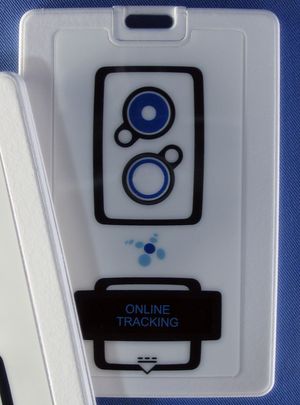Ekahau, a Finnish maker of Wi-Fi real-time locating systems used in the health-care and manufacturing industries, is putting its RFID smarts into a personnel badge, and also equipping it with an LCD screen and text-messaging capabilities. Called the T301-B, the device is an active 2.45 GHz tag that is read by Wi-Fi access points and could be used, for example, by hospital administrators to first locate and then message a nurse or doctor wearing the badge. It would prove an effective alternative to using a pager or sending text messages over cell phones, particularly because the use of pagers and cell phones is restricted in hospitals to reduce the potential of RF interference with biotelemetric devices, explains Arttu Huhtiniemi, Ekahau’s director of product management.
When someone carrying the badge receives a short text message, that person can confirm receipt of the message by pressing a receipt button on the tag. The T301-B can also be used as an asset tag, in which case the text message would provide employees with a visual indication of an asset’s status, such as “rented” or “reserved.” The message function can also work in a factory, where the tags could be attached to goods being manufactured to track their location and indicate their production status on the screen.
In addition, the T301-B can be used in safety and security applications because it has an alarm integrated into the loop through which a lanyard can be clipped. Personnel wearing the tag can yank on it, releasing the loop and sending a distress signal to a system administrator. This feature is critical for compliance with European Union regulations stating that for personnel working alone in hazardous environments, employers must provide a resource to call for help in an emergency, according to Ekahau.
Older Ekahau tags also offer this functionality, explains Huhtiniemi, but the bulky size of those models makes them unattractive to use as personnel badges. The company’s third-generation T301-A tag, which debuted in June 2006, has two programmable buttons that can be configured so that the user can send alarms or other messages, and it has two LEDs and a buzzer that can be remotely activated to communicate with the person holding the tag. Ekahau’s second-generation T201 tag, launched in March 2005, features an audio buzzer, two red/green LEDs and a call button for sending alerts, including the location of the alerter, to security personnel or caregivers. Although these earlier tags are being used in factories to track works-in-progress, according to Ekahau, neither model supports text messaging.
To track the location of the T301-B tag, end users must use Ekahau’s positioning engine software, which analyzes a number of factors, including the strength of the tag’s signal, to determine its location. While a facility’s existing wireless access points are used instead of special readers, an end user might need to install additional access points in order to enable more granular tracking of the tags and the assets, personnel or manufactured items to which they are assigned.
The messages are sent to the tag through an application- programming interface that links the positioning engine to Ekahau’s Tracker application, which takes the tag location data derived in the positioning engine and provides a real-time view of the tracked area and the location of tags in that area. This application is also used to dispatch alerts or messages to the tags in the field, or receive alerts from the tags. To send a text message to a T-301B tag, a person would use a PC to search for a specific tag listed in the Tracker or third-party application. Once the tag is located, the user would type in a message, click on the send command, and the message would be sent to the tag. A third-party tracking program, which would also provide graphical views of the deployed tags and enable messaging to and from the tag, could be used instead of the Tracker application, through an API to the positioning engine.
Huhtiniemi says that the amount of time a T301-B can be used on a single charge is highly dependent on its use and on how regularly the messaging screen is in use and powered—a switch enables the user to disable the screen. “If you keep the screen on all the time, you can run the tag for a number of days. If there is no display use, then it would run for a longer time,” he says, adding that the tag’s rechargeable lithium battery could be recharged for a number of years. To conserve battery power while the screen is turned on but not in active use, the tag puts the screen in sleep mode.
Ekahau is also making a version of the T301-B without the messaging screen, for users not interested in the messaging functions. Ekahau is currently sending samples of its tags to customers. The tags will be commercially available during the second half of 2007 through Ekahau resellers and partners worldwide. Huhtiniemi says that pricing has not yet been set, but that the difference in price between the version of the tag with the screen and without is likely to be about $10.


